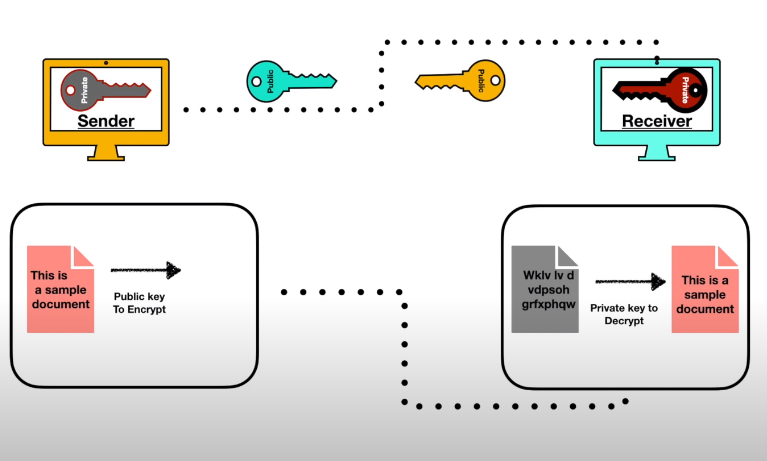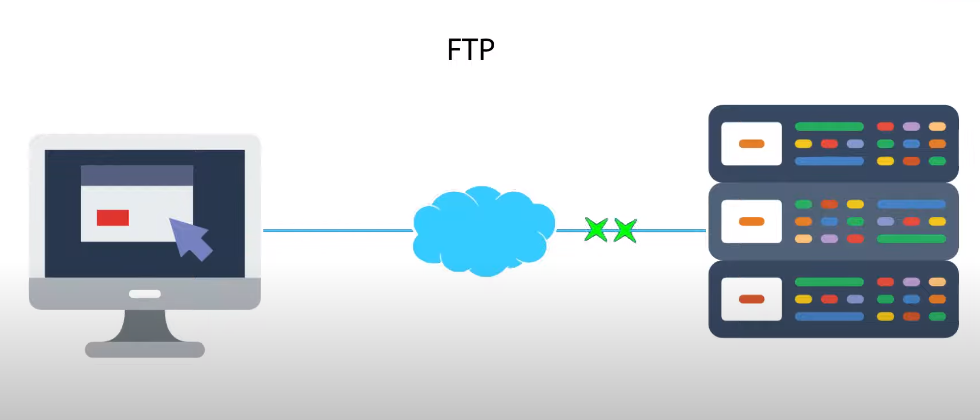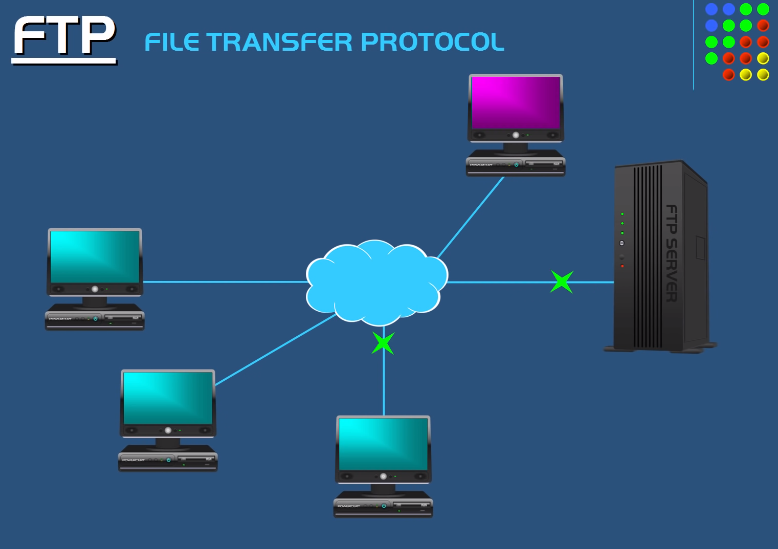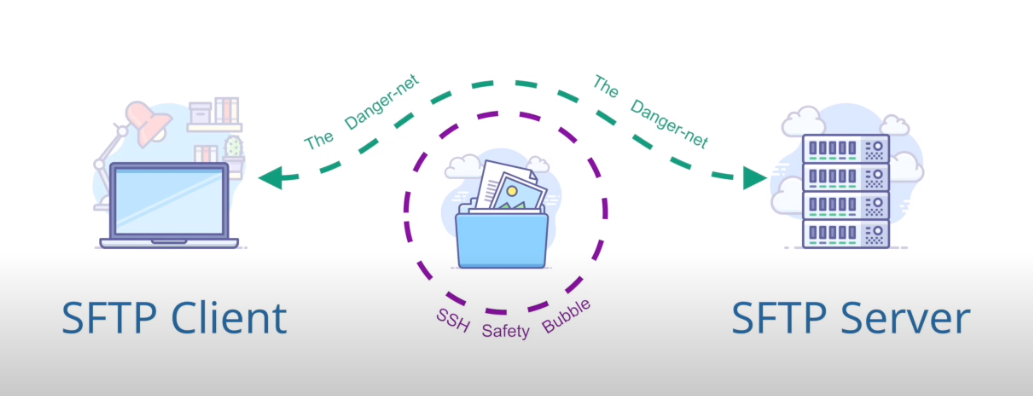The Ubiquity of FTP
File Transfer Protocol (FTP) does not encrypt data by default, meaning that any data transferred using FTP can be intercepted and read by anyone with access to the network traffic. This lack of encryption makes FTP vulnerable to various security threats, including eavesdropping, data tampering, and unauthorized access. However, there are ways to secure FTP transfers. One option is to use Secure FTP (SFTP), which encrypts data using Secure Shell (SSH) protocols.
Need For Secure File Transfer Protocols
FTP has been a popular file transfer protocol for many years, but its lack of encryption has made it increasingly vulnerable to security threats. As more sensitive data is being transferred over networks, the need for secure file transfer protocols is becoming increasingly important. Secure FTP (SFTP) is a protocol that provides encryption and secure authentication mechanisms to protect data during transfer. Other secure file transfer protocols include HTTPS, FTPS, and AS2, each with its own strengths and weaknesses.
Understanding FTP Protocol
The FTP (File Transfer Protocol) is a standard network protocol used to transfer files from one host to another over a TCP-based network, such as the internet. It was first introduced in 1971 and has since undergone several revisions to improve its functionality and security. FTP uses two channels to transfer files: the control channel and the data channel. The control channel is used to send commands and responses between the client and the server, while the data channel is used to transfer the actual files.
Difference Between Active And Passive FTP
Active FTP and Passive FTP are two modes of FTP communication that differ in how they establish connections between the client and server. In Active FTP, the client initiates a connection to the server on port 21 (the default FTP port) and specifies a port number for the server to connect back to the client on. This port number is typically a high-numbered port, such as 1024 or higher.
What is Encryption?

Encryption is the process of converting plain text or data into a coded message to prevent unauthorized access. It involves the use of an algorithm and a key to transform the original data into an unreadable format that can only be decoded with the correct key. Encryption is commonly used to protect sensitive data such as passwords, credit card numbers, and other confidential information during transmission over the internet or storage on a device.
Importance of Encryption
Encryption is extremely important in today’s digital age where sensitive information is constantly being shared and stored. It helps to protect data from being accessed by unauthorized individuals or entities, such as hackers or cybercriminals. Encryption also helps to ensure the privacy and confidentiality of personal and sensitive information, such as medical records, financial data, and personal communications. Without encryption, this information would be vulnerable to theft, manipulation, and misuse. Overall, encryption plays a crucial role in securing digital communication and protecting sensitive data.
How Encryption Works With FTP?

FTP (File Transfer Protocol) is a standard network protocol used for transferring files between servers and clients over the Internet. Encryption can be used with FTP to secure the data being transferred. There are two common ways to implement encryption with FTP:
Vulnerabilities of FTP
Encryption can be used with FTP (File Transfer Protocol) to secure the transfer of files between two devices. This is typically done using SSL/TLS (Secure Sockets Layer/Transport Layer Security) encryption, which encrypts the data being transferred and ensures that it can only be decrypted by the intended recipient. Without encryption, FTP is vulnerable to several types of attacks, including eavesdropping, data tampering, and password interception.
FTP And Plaintext Transmission
FTP (File Transfer Protocol) is a standard network protocol used to transfer files from one host to another over a TCP-based network, such as the Internet. However, FTP does not provide any built-in encryption, which means that all data transmitted over FTP is sent in plaintext, making it vulnerable to eavesdropping and data tampering.
Risks of man-in-the-middle Attacks
Man-in-the-middle (MITM) attacks are a common type of attack that can exploit the lack of encryption in FTP and plaintext transmission. In a MITM attack, an attacker intercepts the communication between two parties and can eavesdrop on the conversation, modify or inject data, or even impersonate one of the parties to gain access to sensitive information.
Vulnerabilities of FTP Servers
FTP servers are vulnerable to a number of security risks, including:
1. Brute force attacks: Attackers can use automated tools to guess usernames and passwords to gain unauthorized access to the FTP server.
2. Malware: FTP servers can be infected with malware that can be used to steal data or launch attacks on other systems.
3. Denial of Service (DoS) attacks: Attackers can flood the FTP server with traffic to overwhelm it and make it unavailable to users.
What is FTPS?
FTPS (File Transfer Protocol Secure) is a secure version of FTP that uses SSL/TLS encryption to protect data in transit. It provides a more secure way to transfer files between systems, as it encrypts both the data and the authentication process. FTPS is commonly used in industries that require high levels of security, such as healthcare and finance.
How FTPS Encrypts Data?
FTPS encrypts data using SSL/TLS encryption. SSL (Secure Sockets Layer) and its successor TLS (Transport Layer Security) are cryptographic protocols that provide secure communication over the internet. When a client connects to an FTPS server, the server sends its SSL/TLS certificate to the client. The client verifies the certificate and establishes a secure connection with the server. All data transferred between the client and server is encrypted using SSL/TLS, which prevents unauthorized access to the data.
Difference Between FTPS and FTP

FTPS (File Transfer Protocol Secure) is a secure version of FTP that uses SSL/TLS encryption to protect data during transfer. On the other hand, FTP (File Transfer Protocol) is a standard protocol used for transferring files between computers over the internet. However, FTP does not provide any encryption, which means that data transferred using FTP can be intercepted and read by unauthorized parties. This makes FTP less secure than FTPS.
What is SFTP?

SFTP (Secure File Transfer Protocol) is another secure version of FTP that uses Secure Shell (SSH) to encrypt data during transfer. SFTP provides a more secure way of transferring files compared to FTP and FTPS because it encrypts both the data and the commands used to transfer the data. This makes it more difficult for unauthorized parties to intercept and read the transferred data. SFTP is commonly used for transferring sensitive data such as financial information, personal data, and confidential documents.
How SFTP encrypts data?
SFTP encrypts data using Secure Shell (SSH) protocol, which provides a secure channel for data transfer. When a file is transferred via SFTP, the data is encrypted before it is sent over the network. SFTP uses a combination of symmetric and asymmetric encryption to encrypt the data. Symmetric encryption is used to encrypt the data itself, while asymmetric encryption is used to encrypt the key used for the symmetric encryption.
Comparing FTPS, SFTP, and FTP
FTPS, SFTP, and FTP are all protocols used for file transfer, but they differ in terms of security and encryption.FTPS (File Transfer Protocol Secure) is an extension of FTP that adds support for Transport Layer Security (TLS) and Secure Sockets Layer (SSL) encryption. It encrypts both the control and data channels, providing a high level of security for file transfer.
SFTP (Secure File Transfer Protocol) uses SSH to encrypt data and provides a secure channel for file transfer. It is considered more secure than FTPS because it uses a combination of symmetric and asymmetric encryption to protect the data.
FTP (File Transfer Protocol) is the oldest and most basic protocol for file transfer. It does not provide any encryption or security measures, making it vulnerable to attacks and data breaches.
In summary, if security is a top priority, SFTP or FTPS should be used instead of FTP. SFTP is considered more secure than FTPS due to its use of both symmetric and asymmetric encryption.
Advantages And Disadvantages of Each
There are numerous advantages to be gained from a variety of different activities, behaviours, and practices. For instance, regular exercise can lead to improved physical health, increased energy levels, and a more positive outlook on life. Similarly, practising mindfulness and meditation can help reduce stress and anxiety, improve focus and concentration, and promote a sense of inner peace and tranquillity. Additionally, building strong relationships with family, friends, and colleagues can provide a sense of belonging, support, and emotional fulfilment. Investing time and energy in personal growth and development can lead to increased self-awareness, confidence, and a greater sense of purpose and direction in life. Finally, engaging in hobbies and creative pursuits can provide a sense of enjoyment, fulfilment, and a break from the stresses and pressures of daily life. Overall, there are many advantages to be gained from a wide variety of activities and practices, and it is up to each individual to determine which ones are most meaningful and beneficial for them.
Implementing Secure File Transfers
When it comes to implementing secure file transfers, there are a few key steps that you can take to ensure that your data is protected. First and foremost, it’s important to choose a secure file transfer protocol, such as SFTP or HTTPS. These protocols use encryption to protect your data in transit, making it more difficult for unauthorized users to intercept or access your files.
Securing FTP servers
Securing FTP servers is another important step in ensuring the security of your file transfers. This can include implementing strong authentication measures, such as requiring users to use strong passwords or two-factor authentication. Additionally, you can limit access to your FTP server to only authorized users and regularly monitor your server for any suspicious activity.
Conclusion
In conclusion, while FTP may be a convenient way to transfer files, it poses several security risks that should not be ignored. It is important to consider alternative methods such as SFTP or HTTPS, which offer stronger security measures to protect sensitive data. Additionally, implementing strong passwords and regularly updating them can help mitigate the risk of brute-force attacks. Overall, it is crucial to prioritize security when transferring files to ensure the protection of sensitive information.
Frequently Asked Questions
What is The Difference Between FTP and SFTP?
FTP and SFTP are both file transfer protocols, but they differ in how they secure the transfer of files. FTP transfers files in plain text, meaning that the data can be intercepted and read by anyone with access to the network. SFTP, on the other hand, uses encryption to protect the data being transferred, making it more secure than FTP. SFTP also uses SSH (Secure Shell) for authentication, which adds an extra layer of security.
How do I know if my FTP connection is secure?
To determine if your FTP connection is secure, you can check if it uses FTPS (FTP over SSL/TLS) or SFTP (SSH File Transfer Protocol). If you are using FTPS, you can look for a padlock icon in your web browser’s address bar, which indicates that the connection is encrypted. If you are using SFTP, the connection is already encrypted and secure.
Is FTP still in use today?
Yes, FTP is still in use today, although it is not as popular as it once was due to security concerns. Many websites and servers have switched to more secure file transfer protocols such as SFTP or FTPS. However, there are still some situations where FTP may be used, such as for transferring large files or for legacy systems that do not support newer protocols.
What is the difference between FTPS and SFTP?
FTPS (File Transfer Protocol Secure) and SFTP (Secure File Transfer Protocol) are both secure file transfer protocols, but they differ in the way they establish and maintain a secure connection.FTPS uses SSL/TLS (Secure Sockets Layer/Transport Layer Security) to encrypt the connection between the client and the server. It requires a separate SSL/TLS certificate to be installed on the server, and it uses two separate channels for data transfer and control.
What are the risks of using FTP?
Using FTP (File Transfer Protocol) can pose several security risks. Firstly, FTP transfers data in plain text, which means that any sensitive information, such as usernames and passwords, can be intercepted and read by hackers. Secondly, FTP does not have built-in encryption, so any data transferred through FTP is vulnerable to interception and tampering. Lastly, FTP servers can be vulnerable to attacks such as brute-force attacks, where hackers try to guess usernames and passwords to gain access to the server.
